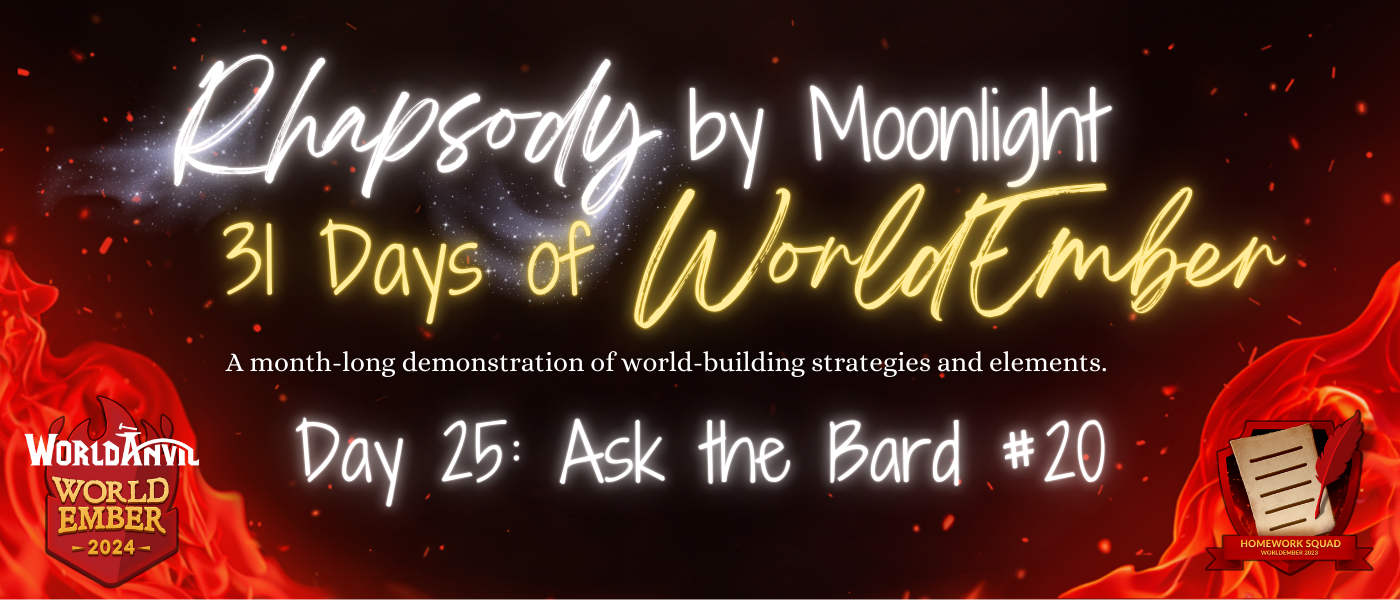Day 25: Ask the Bard #20
Follow along with my WorldEmber progress!
I promised you a look over my shoulder this month as I bring a vague and disjointed collection of ideas together into a cohesive piece of world-building. These resources will help you keep track of my progress through this month-long marathon challenge:
- Haly’s Official WE Progress Report — each participant gets a page that automatically collects their author information and all WE-eligible articles across all worlds into a single, shareable package.
- Haly’s WorldEmber on Argentii Index — an on-the-fly journal page and handy sidebar displaying only new Argentii WE-eligible articles.
Q: Does society make the characters or do the characters make society? When world building, which one should you start with first?
A: TL;DR: Does life reflect art, or does art reflect life?
Assume the person asking the question (me) has a plot but no specific characters or society yet. And how does one make their art reflect life more gooder? LOL
Alright, let’s begin with the repeated assertion that there is no wrong place to begin, there are only places that make better starts than others. Right? Right.
So, you have a plot. “I want to tell a story about a jewel heist on board an airship, and I have a really clever twist for how they get the jewels off of the ship without getting caught.” Plot. No characters. No setting.
As a writer, I love it when ideas strike me plot-first. Mostly because they never do and so it makes for a novel change. (Ba-dum tiss.) Still, when they do it always feels exactly how I imagine I would feel if I found a bottle washed up on the shore with a treasure map curled up inside!
The mystery! The adventure! Who are these people? What is driving them to do this crime? How am I going to overcome that hurdle in every heist where we have to make our audience care about and root for a felon?!
Oops. Looks like teasing character and society apart isn’t quite so easy. Again I ask…does art reflect life or does life reflect art?
People are products of their society the same as a society is the product of the people within it. “But Haly, you only asked character questions there? How are you getting anything ‘societal’ out of this?”
Rhapsody by Moonlight is built on a “Pay What You Want” model.
Please show your support by buying me a coffee on Ko-fi!
I chose a heist as an example for a reason. A “heist story” is one of those genres that has a very clear list of tropes to tick off one-by-one. The head, the face, the hands, the bankroll, the driver, the squeeze, the demo, the IT guru, the outside expert, the distraction, and the mark.
Each of these characters has a certain set of skills that are required to make the heist work. The mark, for example, the person who’s being stolen from. In Ocean’s Eleven (2001), this was Andy Garcia’s character, Terry Benedict. In Star Wars: Scoundrels by Timothy Zahn, the mark is a Black Sun crime boss named Avrak Villachor.
Benedict is a billionaire casino owner. Villachor is a particularly vicious mob boss into drugs, weapons, extortion, and murder. They are both products of societies that, at the same time, love and revile them. They both started out as tough kids on the lower end of the socio-economic scale who used grit and determination to climb over everyone in their way. They chose this route because, from their perspective, that was what society had done to them.
Let’s face it, nepotism and generational wealth don’t breed the gumption it takes to become a Terry Benedict, Al Capone, or Avrak Villachor. So, what does society look like from the poor side of town and the wrong side of the tracks? That interplay is a solid framework on which to develop your villain, ANY villain, regardless of genre.
A brief aside that’s too important for a footnote and should be a sidebar: If you go the lazy route and say that your villain is the product of some well-researched emotional or mental instability, then you STILL need to look at the societal pressures that made this person snap into a criminal. Plenty of people with disorders lead peaceful and law-abiding lives.
So, if you have a plot, then start with characters. And when you start with characters, start with The Villain. Why? Because it’s important to nail down the limits, the extremes, first. Once you know how bad bad is, then you can determine the opposite. Because in art, as in life, characters are very rarely extreme. They are most often a mixed bag of mediocrity with maybe a splash of excess here or there.
Even Hercules was only half a god.
The most extreme character will point out to you the most extreme parts of society. From there, it’ll be much easier to build compelling, life-like, flawed characters that we can cheer on and identify with, in conjunction with a society that feels all the more real for how well they fit within its unspoken limits.
Hope this helps!








Comments